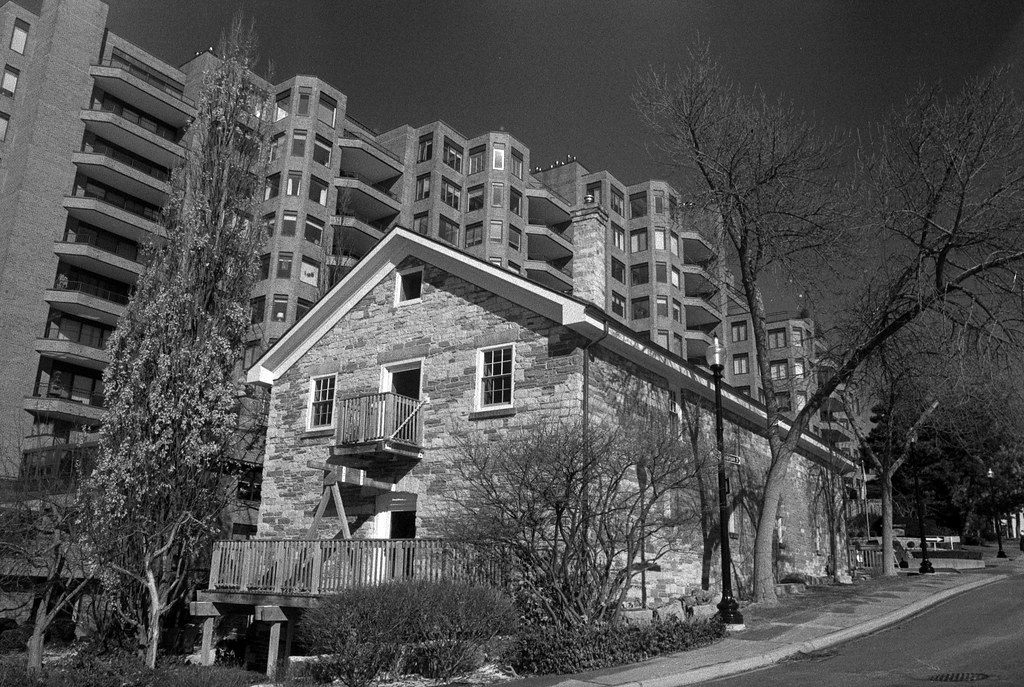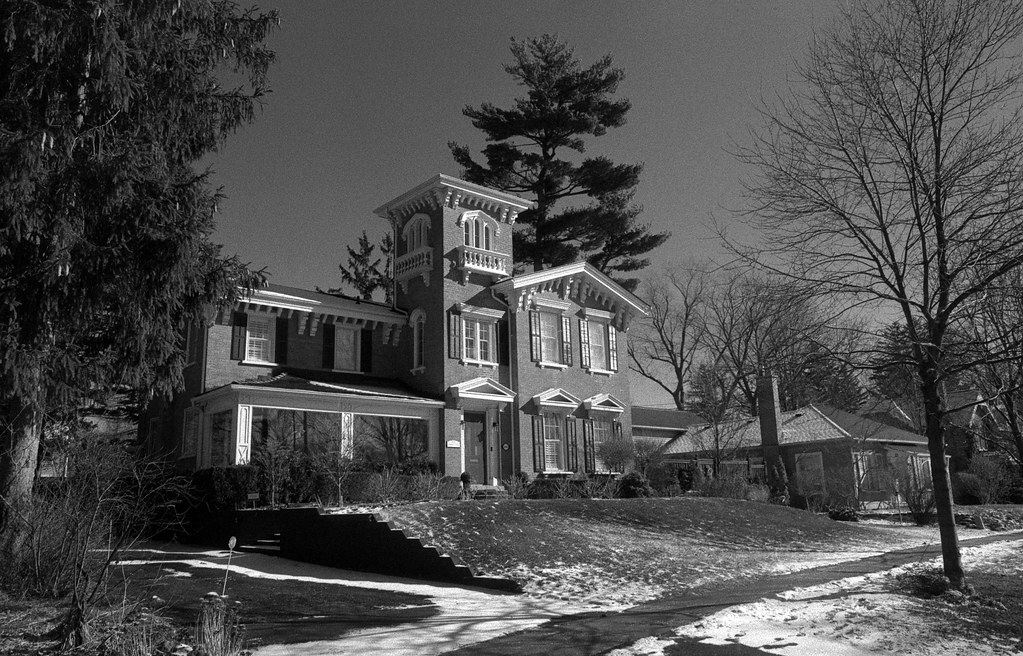The historic downtown of Oakville has always been a bit of a respite for me and my photography since I started taking it seriously. It also helps that working fifteen minutes north of this space allows me an easy lunch break escape to relax in an urban environment. But my experience with downtown Oakville goes back further than working at Sheridan. Back in 2002, I attended PYPS Fall Convention at Knox Church. That event stands out in my mind for several reasons. First, I met several longtime friends at that event. The second I did my first serious photography at a PYPS event, and third I actually met a Chisholm (you’ll understand after the next paragraph). Yes, even these days when things are exactly ideal given the season. Oakville’s historic downtown has also featured fairly prominently in my past fifty-two roll projects. Hence, it only made sense to head out there again in the winter after a fresh snowfall to capture the space once again.

Nikon FM – AI Nikkor 28mm 1:3.5 (Yellow-12) – Fomapan 400 @ ASA-200 – FPP D96 (Stock) 7:30 @ 20C
The human settlement of what would become Oakville is traced back thousands of years, but the first permanent settlements were by the Wendat people back in 1400 CE. After contact with the French, the Wendat were known to the French as the Huron. The Beaver Wars of the 1600s, the Haudenosaunee spurred on by the English and Dutch to push into the territory of the Wendat and Neutral peoples saw, by 1650 much of the land once occupied by both peoples entirely occupied by the Haudenosaunee. Members of the Haudenosaunee, the Cayuga, Seneca, and Oneida all established villages throughout Lake Ontario and the two main rivers. But they, pushing for land, headed north at the end of the 1600s into the traditional lands of the Anishinaabe, but they pushed back. And eventually, the Anishinaabe pushed south into the area removing the Haudenosaunee. The American Revolution generated a group of Crown Loyalists fleeing the Thirteen Colonies’ rebellion and headed north. Those indigenous peoples, known to the British as the Mississaugas began to enter into (often unfair) treaties to surrender or sell their lands to the British Crown with the first treaties being signed in 1781. The first major road to run through the Dundas Road area but far north of the lake. Additional territory was added in 1809, and Samuel Wilmot surveyed the Colonial government. Under Wilmot, three townships were created, and the county of Halton formed of those three. Initially known as Nelson, Alexander, and Toronto, Alexander was changed to Trafalgar after the great British victory. Small settlements did spring up, but most major colonial expansion started in the Post War of 1812 era. The Mississaugas, initially holding onto several natural harbours, were forced through starvation and attrition. European settlement’s rapid expansion sold the harbours around the Twelve Mill Creek and Sixteen Mile Creek in 1820 to the Crown. Further surveys were conducted, and they went up for auction in 1827. The Sixteen Mile Creek land interested William Chisholm. Chisholm, a loyalist, had until recently had trouble making a name for himself, mostly due to his connection to the Reform Movement and Radical William Lyon MacKenzie. But after switching sides to the Tories, he soon found the power and prestige he sought and was the successful bidder on the Sixteen Mile Creek land. Chisholm appointed his son Robert Kerr and son-in-law Merrick Thomas to survey to lay out the townsite. The natural harbour was enlarged and protected, and a shipyard established. Chisholm envisioned a major port town to move goods, mainly grain and timber from further north along the Sixteen Mile Creek out to market. The creek also provided the power needed to operate mills along the bank. By the time William arrived in 1838, the small village was already booming with a successful shipyard and port of entry where Chisholm operated a small customs house out of a modest brick store. Oakville’s name came from the vast tracts of white oak that occupied the area and made for excellent shipbuilding material. Sadly William would not see the village boom, passing away in 1842. By 1846 the village boasted three churches, two mills, the shipyard and harbour. Along with a small manufacturing industry. Robert Kerr Chisholm, who took over his father’s role as custom’s agent, began constructing a customs house and a modest estate for his family. The Customs House would see completion in 1856, and in 1858 the Erchless Estate would also see completion. In 1857, Oakville was incorporated as a town but lost out to Milton for Halton County’s seat. Much to their annoyance. William’s eldest son, George King Chisholm elected as the first mayor. The arrival of the Great Western Railroad, north of the town’s core threatened the shipyard and grain export it also didn’t help that the entire grain economy in Canada collapsed. The next two decades brought additional hardship with a major factory burning down and the shipyard’s closure in 1874 that saw several smaller businesses close as a result. The Chisholm’s were unable to sell the shipyard to a private owner eventually sold it to the town, which still operates it as a public harbour. The city turned to agriculture, mainly strawberries, which presented a new tourist industry to grow as steamships from the industrial cities of Toronto and Hamilton to seek rest among the orchards. Wealthy business barons saw the pastoral lakeshore as ideal and began to build their summer homes and estates in Oakville and use the train to travel into the cities. This was made all the easier as the motor car and paving of Lakeshore Road, later Provincial Highway 2 allowed better automobile traffic. The heavy industry wouldn’t return until the middle of the 20th Century with petroleum refineries, rail car production, and the post-war era Ford of Canada opened their new national Headquarters and production plant in 1953. Oakville would annex the smaller communities surrounding their historic core in 1962 with the modern boundaries being fixed in 1974.

Nikon FM – AI Nikkor 28mm 1:3.5 (Yellow-12) – Fomapan 400 @ ASA-200 – FPP D96 (Stock) 7:30 @ 20C
Nikon FM – AI Nikkor 28mm 1:3.5 (Yellow-12) – Fomapan 400 @ ASA-200 – FPP D96 (Stock) 7:30 @ 20C
When you photograph an area as much as I do with downtown Oakville despite not living here, you get a list of buildings that you must include in any project related to Oakville. But narrowing that list down to seven images and only having about an hour to actually shoot your roll of 36 can be difficult. I made a point to write out Oakville’s history first, hoping to help that narrative drive the image choices. Because like the words, the images must also tell a story themselves and support the written narrative. Thankfully, I was able to quickly pick out the seven images by just trusting my gut. The featured image became apparent and was the last frame on the roll looking down Lakeshore west into the downtown. The next two were relatively straightforward with the titular Erchless, although from a different angle than I usually take the grand home from. The reason being that I could show off all the layers of the home, which still includes the original 1835 brick store, 1839 expansion and Robert Kerr’s 1858 addition. And I couldn’t have the Chisholm home without showing off Merrick House and original Post Office from 1828 and 1838 respectively, and yes, both are original. Another two that came quickly to my mind was the 1828 Chandlerly building, the only serving building from Oakville’s once-thriving shipyard and the 1855 grain warehouse both from Oakville’s original purpose and industries. While the final two didn’t fit, I didn’t stand to leave them out of the post; the first is a favourite home along with Trafalgar north of the downtown, Potter’s Folly a rare example of Italianate Villa, there is another similar home downtown but I always include that in posts, and besides, I’m using that home in another blog post. And finally filed under ‘one of these things’ is the 1908 Oakville Trafalgar High School Building. While much of the school’s expansions are gone, leaving only the historic building, I once many years ago tried to get inside, but failed (I did see a couple of access points) plus my mom taught a semester here in 1982. But this is the closest I’ve gotten to the building in years, so I had to include the shot if not the last one in the post.

Nikon FM – AI Nikkor 28mm 1:3.5 (Yellow-12) – Fomapan 400 @ ASA-200 – FPP D96 (Stock) 7:30 @ 20C
Nikon FM – AI Nikkor 28mm 1:3.5 (Yellow-12) – Fomapan 400 @ ASA-200 – FPP D96 (Stock) 7:30 @ 20C
Usually, when I’m in such an environment I’ll tend to stick to my 35mm lens, but not this week, I decided instead that because of the narrower streets that make up the historic core of Oakville I went again with my 28mm wide-angle, this time adding a pale yellow filter to the lens to give a bit of additional contrast and sky separation. For shooting, I’ve given it my usual one-stop overexposure (shooting at ASA-200) mainly because I want to try pull-processing in FPP D96 (Kodak D-96) while designed as a motion picture developer, I’ve seen good results on Flickr of the combination and found a development time online. And I was presently surprised when I saw the negatives and even more blown away when I got the images into the scanner. In fact, even in the examples, I saw online did not look like my results. I’ve never seen Foma 400 behave in this way at all, and personally, I think it’s awesome. There’s a dynamic tone to all these images with a near scary black sky (it was high-noon, no clouds and a deep blue sky). Not only that but all the details in the trees are on full display.

Nikon FM – AI Nikkor 28mm 1:3.5 (Yellow-12) – Fomapan 400 @ ASA-200 – FPP D96 (Stock) 7:30 @ 20C
Nikon FM – AI Nikkor 28mm 1:3.5 (Yellow-12) – Fomapan 400 @ ASA-200 – FPP D96 (Stock) 7:30 @ 20C
Stay tuned for next week where I return to Milton and thanks to a snowstorm get stuck in my own neighbourhood.
1 Comment